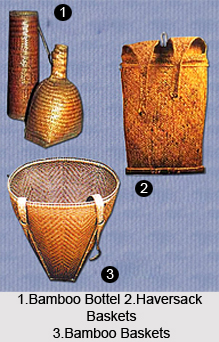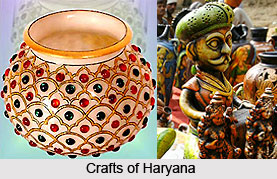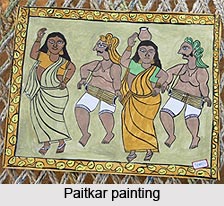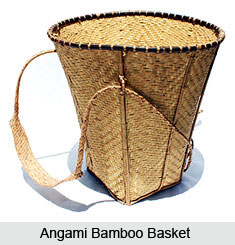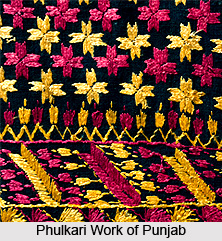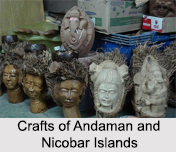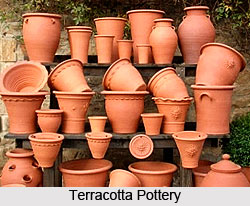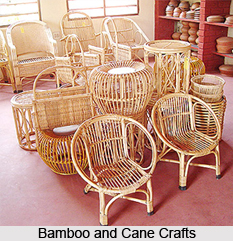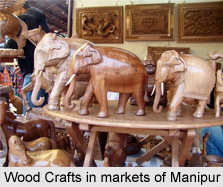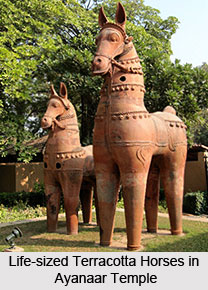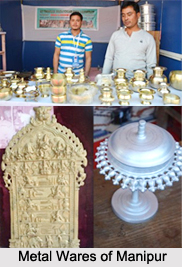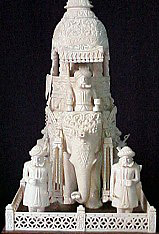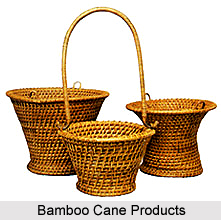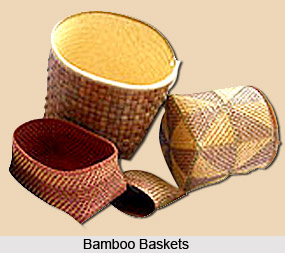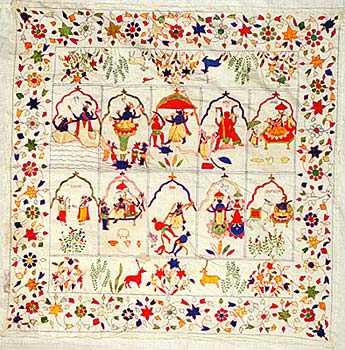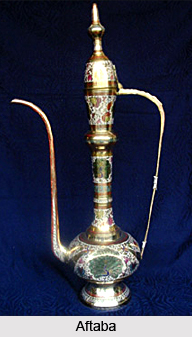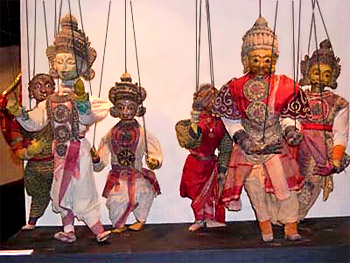Introduction
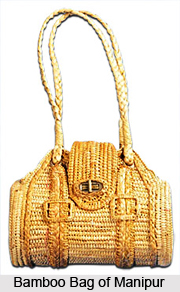 The bamboo and cane crafts of Manipur have a huge variety that range from traditional from modern creations. The raw materials required for the bamboo and cane crafts of Manipur are amply found from the forest resources that are grown in Churachandpur, Jiribam, Tamenglong and Imphal districts. Some of the bamboo and cane items that are hugely prepared in Manipur are sofa sets, Murhas, mats, basketry, tray, chair, table, flower vase, ashtray and other decorative and utility articles. The screens of Manipur consist of beautiful room dividers stage and `mandap` backdrops. They are delicately woven and crafted out of bamboo and cane.
The bamboo and cane crafts of Manipur have a huge variety that range from traditional from modern creations. The raw materials required for the bamboo and cane crafts of Manipur are amply found from the forest resources that are grown in Churachandpur, Jiribam, Tamenglong and Imphal districts. Some of the bamboo and cane items that are hugely prepared in Manipur are sofa sets, Murhas, mats, basketry, tray, chair, table, flower vase, ashtray and other decorative and utility articles. The screens of Manipur consist of beautiful room dividers stage and `mandap` backdrops. They are delicately woven and crafted out of bamboo and cane.
Moreover, Manipur is also well known for its beautiful baskets created by the tribal people for their own use. Intricate patterns with dyed bamboo are worked on these baskets. The basketry of Manipur has a special feature that includes bamboo fish traps, which are so exquisitely crafted as to be almost sculptural. Another variety of baskets, the chengbon (a square body of checks and squares in black and white, and rest on four prominent legs and are used for storing clothes) have a domed lid made of bamboo. Excellent reed mats and cushions are also woven in Manipur, locally known as `kounaphak`. Another type of double-weave mat known as `phak` is woven in the state. These as well as the mats and baskets are in much demand outside Manipur.
The bamboo and cane crafts of Manipur include making exclusive baskets. Among them baskets that are widely used in Manipur as well as other states are measuring baskets, Miruk, Filtering Baskets, Container Baskets, Conical Baskets etc. In the remote areas of Manipur, long bamboo tubes hollowed out sufficiently, are used for containing drinking water. These are stored inside the house, often piling one upon another. The tribal people of Manipur and the adjacent areas use a container basket called `Rashakok`. This basket is finely woven in the open weave style with thin bamboo splits. The womenfolk in the valley use a bowl-shaped fishing basket named as `Long` to catch fish in shallow water. The body of `Long` is woven with bamboo splits. Baskets woven in the pattern of diagonals filled in to the texture of the open hexagonal weave are represented as effigies of fowl in death rituals, which the people in the hills conduct in the memory of their forefathers.
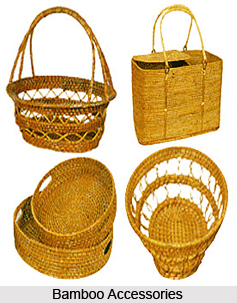 Apart from the utilitarian items, the craftsmen create headgears and ornaments out of bamboo and cane splits. Tribal people use a headgear, woven with cane splits, which is made to fit neatly like a cap which is worn while performing tribal dance. The bamboo and cane crafts of Manipur include making `Khudangyai` or wristlet and `Khubomyai` or anklet respectively. The anklets and wristlets, besides being a form of decorative ornament, serve as protective gear in battles, fights, etc. Another popular craft made out of bamboo and cane is the basket-effigies that are used on the occasion of a "Feast of Merit" to inaugurate a newly-built house, and also in rituals performed to drive away evil spirits. Some of the tribal groups put up effigies made of bamboo that represent human skulls. These are placed on the verandah of the house among the inhabitants of Manipur. The local people at the time of the Umanglai Haroaba (Festivities of the Sylvan Deities) place brass masks, representing the Umanglais inside baskets made of bamboo splits. The baskets with brass masks are worshipped as images of the Deities.
Apart from the utilitarian items, the craftsmen create headgears and ornaments out of bamboo and cane splits. Tribal people use a headgear, woven with cane splits, which is made to fit neatly like a cap which is worn while performing tribal dance. The bamboo and cane crafts of Manipur include making `Khudangyai` or wristlet and `Khubomyai` or anklet respectively. The anklets and wristlets, besides being a form of decorative ornament, serve as protective gear in battles, fights, etc. Another popular craft made out of bamboo and cane is the basket-effigies that are used on the occasion of a "Feast of Merit" to inaugurate a newly-built house, and also in rituals performed to drive away evil spirits. Some of the tribal groups put up effigies made of bamboo that represent human skulls. These are placed on the verandah of the house among the inhabitants of Manipur. The local people at the time of the Umanglai Haroaba (Festivities of the Sylvan Deities) place brass masks, representing the Umanglais inside baskets made of bamboo splits. The baskets with brass masks are worshipped as images of the Deities.
The bamboo and cane crafts of Manipur incorporate making musical instruments.
The Lambang tribals contrive cut tubes of a small variety of bamboo to make a flute-like-wind musical instrument called `Puleh`. The Maring tribals use a similar musical instrument called `Toutri` which is called `Theibe` among the Koms. The Thadou tribals of Manipur cut three tubes of different lengths from the same bamboo stem and the tubes are separately blown with the mouth to produce different musical notes. Another musical instrument is `Relru`. Many of the tribal groups configure fine bamboo splits or Paya to make an interesting musical instrument that is played with the mouth.
Another distinct style of the Bamboo and cane crafts of Manipur is the bamboo-umbrella or `yenpak`, worn or borne on the head to ward off heat and rain while going to work and even when working in the paddy-fields. The types of `Yenpak` varies from `Yenkhrung,` `Salaitep` and `Yengoi`. Totems in the form of tall bamboo poles decorated with three to nine circular bamboo rings, draped with cloth cut in geometrical shapes, are a marked feature of a tribal society of Manipur. These totems are known as Shattra. These exclusive totems are also used in rituals connected with "shifting of ponds, "shifting" of temples, etc., and in death ceremonies and "Phiroi"(first death anniversary), etc. Still the combs offered to the Deities for rituals, ceremonies, etc are still made of bamboo, a distinct example of bamboo and cane craft of Manipur. In the hills, some of the tribals groups still use bows and arrows made of bamboo. Cut bamboo pieces are used for making smoking pipes. Tables, chairs, seats, etc made of cane are used profusely. Apart from these items certain toys such as Pichkari or toy water-pump, toy wind sails, etc. are also made of bamboo.
The bamboo and cane crafts of Manipur has an exclusive style and the items created range from utilitarian to stylish décor items from musical instruments to effigies. An array of variety is observed in the creation of the artisans of Manipur.
Cane Products of Manipur
 The Mongoloid culture has been described as the bamboo culture, and the northeast state of Manipur being a part of this culture, is therefore known accordingly. For the Mongoloid people, it is their slogan to eat bamboo, sleep with bamboo, live with bamboo and drink with bamboo. The case is no different in Manipur. While making crafts using bamboo, cane is also added. From time immemorial to the present day, cane and bamboo have been an integral part of the lives of the people in Manipur and the North Eastern region. The Pena singers and other bards in the valley of the state, sing even today about the multifarious uses of both cane and bamboo. However, one does not come across any specific text related to cane and bamboo among the numerous manuscripts written in the archaic Meithei script. There are mentions, though, about the way people utilised cane and bamboo in such ancient manuscripts as the Panthoibi Khonggul, the Poireiton Khunthokpa, the Phanga Chinggoirol and the Yumsharol. From the brief references, it can be inferred that measuring baskets, other type of baskets and traps were used by the people in this region, even in the period before Christ.
The Mongoloid culture has been described as the bamboo culture, and the northeast state of Manipur being a part of this culture, is therefore known accordingly. For the Mongoloid people, it is their slogan to eat bamboo, sleep with bamboo, live with bamboo and drink with bamboo. The case is no different in Manipur. While making crafts using bamboo, cane is also added. From time immemorial to the present day, cane and bamboo have been an integral part of the lives of the people in Manipur and the North Eastern region. The Pena singers and other bards in the valley of the state, sing even today about the multifarious uses of both cane and bamboo. However, one does not come across any specific text related to cane and bamboo among the numerous manuscripts written in the archaic Meithei script. There are mentions, though, about the way people utilised cane and bamboo in such ancient manuscripts as the Panthoibi Khonggul, the Poireiton Khunthokpa, the Phanga Chinggoirol and the Yumsharol. From the brief references, it can be inferred that measuring baskets, other type of baskets and traps were used by the people in this region, even in the period before Christ.
The Ningthourol Lambuba is a manuscript that chronicles the reign of the different Meithei kings, and mentions the use of a carrying basket called "Pai", by the Meitheis. These baskets were hung on the right or left shoulder to carry very light stuff. It is further stated that from about the 17th century onwards, the Pai was gradually phased out amongst the Meitheis and replaced by bags made of cloth. As such, the Meitheis today do not even use the term Pai to describe any particular type of basket. However, the tribal belts inhabiting the hills and the Lois living in places like Andro, Fayang, Laimram, Khurkhul, Sekmai, Shugnu etc. in the valley, still continue to use the terms and names of several articles that were used by the Meitheis centuries ago, with the Pai being one of them.
Col. W. McCulloch in his "Account of the Valley of Munnipore and of the Hill Tribes", gave a defined description of the houses of the Meitheis, during the 19th century, as quoted here - "The dwelling houses of the Munniporees are all of the same form, but those of the rich are larger and constructed of better materials than those of the poor, that is, the posts and beams of the former are of wood, whilst those of the later are of bamboo. The walls of both are of reeds plastered with a mixture of earth and cow dung and the roofs of all are thatched with grass."
Baskets, for example, can be stored up on Lups, which are scaffolds suspended over the fire place for some time and then preserved to last more than two generations. But people generally make and use only those things that are needed in their every day lives. Cane and bamboo articles, thus, are not easily available. The usual practice is to mend again and again even baskets that have passed through generations. Such baskets that are still in use provide the answers to several questions, such as reasons for their different makes, the methods of their make, the varied uses, the changes that had taken place and so forth.
Conical baskets, which are one of the prominent basketry products of Manipur, are still used by the hill tribes with straps, as they are handy in carrying things up and down the steep hill slopes. At one time, according to the ancient scriptures, the Meitheis residing in the valley also used conical baskets, like the Lengkot Sham, in a similar fashion. There is further evidence to the fact that the Lois living in Andro, Fayang, Laimram, Khurkhul, Sekmai etc., used conical baskets as recently as some 20 years back. The shape of such baskets underwent gradual changes when they were used by the people in the valley. They became less conical and four legs or stands were begun to be added to support the bases; loops and other projections acting as hand-hold were also added later on. In the current scenario, the Meitheis generally use baskets that are flat-bottomed and are carried on the head. Such a historical evolution of the baskets, to suit the changing environs can be understood from the physical examination of the available baskets at different places of the region today.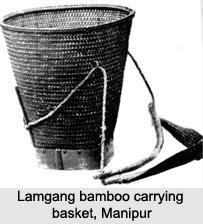
Another method that is used to trace the origin of the types of basketry is their nomenclature. For example, the type of traps known as "Tekhao-lu" originally came in from Assam as Tekhao is the Meithei name for Assam. Similarly, the traps coming from Kabo are known as "Kabo-lu".
The Northeast India accounts for a total of 44 species of Bamboo, out of which 15 are found in Manipur. The varieties of bamboos found in Manipur include 2 varieties of Arundinaria, 6 varieties of Bambusa, 4 varieties of Cephalostachyum and 1 variety each of Dendrocalamus, Melocalamus and Melocauna, all indigenous to the land. The Bambusa and the Cephalostachyum species grow at an elevation of 50 to 500 metres above sea level. The latter can also grow at a higher altitude. The Arundinaria varieties grow at a height of 800 to 3500 metres. Neat bamboo groves are cultivated both in the hills and in the valley of Manipur.
Keeping in tune with the different varieties of bamboo, the craftsmen make several articles and implements, for mostly utilitarian purpose, using different techniques and varied forms. In addition to the bamboo, cane is also used in making household and other utility items. In Manipur, cane is found in the Tamenglong and the Churachandpur districts, growing in abundance in rivulets and along the banks of the Barak River. Cane is also available in lesser quantity in the other hill districts of the state.
The cultural life of the people living in the valley and in the hills of Manipur cannot be imagined without bamboos and their products. The Bamboo plants are closely related to a person"s life, and in one way or the other, even to death. There is no end to the uses and utility of bamboo. The Meitheis, living in the valley distinguish particular varieties of bamboo pertaining to their different uses - bamboo for use in rituals, bamboo for use in the daily lives of people, bamboo for burning scrap and the like and so on. The variety of bamboo that has no practical use is traditionally kept out of the society from amongst the pack of usable bamboo. One of such varieties is the Wareng variety, growing out of the fruits that fall to the ground from the Utang bamboo plant (Bambusa pallid).
In Manipur, it is believed that a family living in a house built without any bamboo can never be a happy one. For the Meitheis, if one is to start a home then there should be a bamboo grove growing on their plot of land. The growth of a bamboo grove is believed to foretell the fortune of a family and for this reason, they are planted by the elders of the family and never by the youths. It is believed that if a youth plants a bamboo seedling, his life span will be curtailed. Again, it is believed that a bamboo flower growing on the grove is a bad omen for the head of the family owning that particular grove. This is perhaps because it is said that bamboo flower increases the fertility of rats, thus increasing their population, which ultimately leads to famine. For the villagers of Laimram, however, the flowering of bamboo is believed to bring good fortune if proper rituals are performed. Naturally enough, the villagers clamour for flowers and when a bamboo grove flowers, some people take a portion of that bamboo and put it in the curry that is being prepared for the family`s meal. This is again believed to bring good fortune to the person eating the food.
Related Articles:
Bamboo, Indian Plant
Bamboo Crafts in India
Bamboo and Cane Crafts of Manipur
Manipur
Crafts of Manipur
Meithei Language
Tribes of Manipur
Baskets
Bamboo Products of Manipur
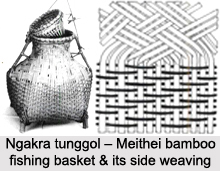 The Meithei community residing in the valley of Manipur, pluck the tender leaves of bamboo on Cheiraoba, their New Year"s Day celebrated in April, and add them to a dish called Utee. This is believed to prevent the bamboo from flowering. Besides, eating such a dish is considered good for the family to avoid a dark fate. However, the dish is not taken by males. If and when there is a full cluster of leaves and tiny branches on the tip of a bamboo plant, it is regarded as an ill omen for the owner of that bamboo grove, since such type of bamboo resembles the Chanduwa bamboo, which is used in funeral pyres. The bamboo that flowers is never used in the construction of houses, but in case of twin bamboo plants in the grove, it is believed that the owning family is blessed with good fortune. If a newly sprung bamboo grows up much higher than the older ones, it is believed that the particular year shall be a happy and prosperous one for the family.
The Meithei community residing in the valley of Manipur, pluck the tender leaves of bamboo on Cheiraoba, their New Year"s Day celebrated in April, and add them to a dish called Utee. This is believed to prevent the bamboo from flowering. Besides, eating such a dish is considered good for the family to avoid a dark fate. However, the dish is not taken by males. If and when there is a full cluster of leaves and tiny branches on the tip of a bamboo plant, it is regarded as an ill omen for the owner of that bamboo grove, since such type of bamboo resembles the Chanduwa bamboo, which is used in funeral pyres. The bamboo that flowers is never used in the construction of houses, but in case of twin bamboo plants in the grove, it is believed that the owning family is blessed with good fortune. If a newly sprung bamboo grows up much higher than the older ones, it is believed that the particular year shall be a happy and prosperous one for the family.
Bamboos with nodes are thought to be just like human beings by the Meitheis, imagined to sleep as humans do and hence, the bamboos incorporated into the framework of the house are deemed sleeping. When a bamboo grows up, the length of the inter-nodes is generally uniform. If there is an irregularity in length of the inter-nodes, say if the length between two certain nodes happens to be quite short, then it is regarded ill to use that particular bamboo as Urep, the main pillar of the house, the reason being the said bamboo is handicapped in its growth and therefore, a person using such bamboo is believed to experience deformity in his body. The occurrence of two nodes growing quite near to each other in the stem of bamboo plant is referred to as Shabou Lonba.
The Meitheis inhabiting the valley also use sacred fire in worship of the Gods. The sacred fire is obtained from the Meiribop (Dendrocalamus hemitonei) bamboo. The Meiribop ("Meiri" implying flame) bamboo is so named as it is believed to emit flames.
The utility of bamboo amongst the Meitheis extends over a much wider range, as is evident from its use in sports and games too. From time immemorial, they have used Kangjei or polo sticks made from bamboo stems, and Kangdrum or polo balls made from bamboo roots, as equipment for the game Sagol Kangjei. It is said that modern polo was derived from Sagol Kangjei and a group of Meitheis got settled between Calcutta and Kharagpur in West Bengal, to manufacture polo balls for the British Army.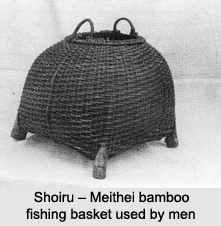
Baskets used by Meitheis
The Meitheis previously used conical baskets extensively for different purposes. Today, their use has dwindled considerably, confined to a limited use today by the men folk in the villages near the foothills. The Meithei women folk of Kwatha village in the Chandel District also use conical baskets. Conical baskets are primarily used for carrying things, such as firewood gathered from the forest, drinking water contained in bamboo tubes, field implements during both the sowing and the harvesting seasons, grain, vegetables and other essentials to and from the market, dismantled loins loom and so on. The conical baskets used for carrying firewood, field implements and bamboo tubes containing water, are usually of the open weave type, i.e., in the pattern of open diagonal filled in to the texture of the open hexagonal weave.
Carrying baskets of all shapes, sizes and hues are used profusely by the Meitheis. The types of carrying baskets are simply classified into two groups as those with straps and the ones without straps. The carrying baskets without straps are normally borne on the head. These are commonly used by the women in the valley. Elongated baskets with bowl-shaped lids, called Phiruk, are used by the Meithei women during marriage ceremonies. They are carried on the head, storing sweetmeats, fruits etc. meant for ceremonies. Another type of basket with lid, called Chengben, is used for carrying clothes. Yet another type of basket with lid used by the Meithei women folk is the Lubak, which is a square-shaped flat bottomed basket used to carry fish to be sold.
The carrying baskets used by the Meithei women, notably the Phiruk and the Chengben, have a peculiar weave wherein separate weaves are done for the inner and outer surfaces. For the inner surface, the weave is simple and is done first. Thereafter, the outer weave is done over the inner weave, that is, a second layer is woven over the first layer. For the outer weave, dyed bamboo splits are used to give a more decorative look to the baskets.
Traditionally, the Meitheis use a small carrying basket called Heijingkharai ("Hei" = fruits; "jing" derived from "Na Ching ba" meaning et cetera; "Kharai" implying open weave basket) in marriage ceremonies. The basket is usually filled with a few varieties of fruits and is then carried by the women of the bridegroom"s side to the bride"s place. The items contained in the basket signify the bride price. Generally, one to three of these baskets are differed as the bride price. The traditional Heijingkharai basket is of a simple make, whereas, its modern version is an elaborately decorated close weave basket. The former is not sold in the market but made on the spot, i.e., on the day of marriage, by an expert who knows how to make one. The modern version is available in the markets. Presently, the traditional Heijingkharai basket is rarely used.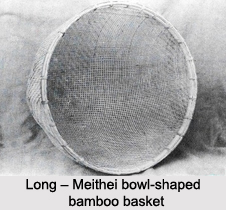
The Meithei Panggens (Manipuri Muslims) use a certain type of basket for carrying fowls, pigeons etc., for selling them at the market. These baskets are of the open weave type. Their mouth is narrow, whereas the bottom is wide along with a bulging middle.
Container baskets for keeping items of daily use are used in Manipur. The Meitheis use such baskets to keep cotton meant for making cloth, wares meant for selling at the market, fruits, betel nuts, betel leaves etc. meant for marriage and religious ceremonies, and also grain, rice and vegetables. The container baskets used by the Meitheis for marriage and other religious purposes is known as Lukmai. In the rural areas, each household in every village has at least one to two of these Lukmais. It is treated almost as a compulsory item in the household. For the urban people who do not own Lukmais, the practice is to hire these baskets from a Lukmaishannba, the person who rents out Lukmais on payment.
The Meitheis also use a particular type of container basket called Chengchamuk, in which finely winnowed rice meant for cooking is put to be washed thoroughly with water. Shelluk is a type of container basket used by Meitheis for storing yarn and shuttle for weaving. A particular type of circular basket is used for winnowing rice chaffs, while a second type is used for drying grain in the sun. The first type is called Yangkok and the second type is referred to as Phoura by the Meitheis. Yet another interesting aspect is that in the event of a death in a Meithei family, the Yangkok used in the household is fixed onto the end of a bamboo pole and is used to fan the burning funeral pyre. The Meitheis use a small basket called Shek for filtering the ash. The Shek is conical, having a circular mouth with a tapering end. On two sides of the circular mouth are extended flaps that act as hand holds. A tiny hole is maintained on the tip of the tapering end, allowing the filtered solution to come out. The ash previously collected is first put into the Shek through the open mouth, and then water is poured over it. The filtered solution that comes out is termed as Kari.
Related Articles:
Bamboo, Indian Plant
Bamboo Crafts in India
Bamboo and Cane Crafts of Manipur
Manipur
Crafts of Manipur
Meithei Language
Baskets
Cheiraoba
Sagol Kangjei
Weaving and Dyeing Craft
Cane and Bamboo Crafts of Tribes of Manipur
 Products made of cane and bamboo are as prominent and indispensable among the tribal belts inhabiting the hills of Manipur, as the Meitheis in the valley. One of such products used by the Maring tribal belt, is a box with lid called Pongsang Lapak, made from the pulpy layer of the bamboo. In making this specific box, the Marings cut up the bamboo into several pieces. The hard outer layer is sliced off bit by bit using a Thangjou, until the pulpy layer within is left fully exposed. The next step is the application of the juice of Khrat, a poisonous plant used by the Marings. It is applied thoroughly all over the outer surface of the bamboo and then heated over fire. This is done to prevent the softer layer of the bamboo from breaking when folded. After being properly exposed to fire, the bamboo piece is split vertically into two. The curved split pieces are then straightened out. Finally, the straightened split pieces are folded into oval-shaped structures which form the framework of the box. The lid and the body of the box are similar in shape, with the body slightly smaller than the lid in size.
Products made of cane and bamboo are as prominent and indispensable among the tribal belts inhabiting the hills of Manipur, as the Meitheis in the valley. One of such products used by the Maring tribal belt, is a box with lid called Pongsang Lapak, made from the pulpy layer of the bamboo. In making this specific box, the Marings cut up the bamboo into several pieces. The hard outer layer is sliced off bit by bit using a Thangjou, until the pulpy layer within is left fully exposed. The next step is the application of the juice of Khrat, a poisonous plant used by the Marings. It is applied thoroughly all over the outer surface of the bamboo and then heated over fire. This is done to prevent the softer layer of the bamboo from breaking when folded. After being properly exposed to fire, the bamboo piece is split vertically into two. The curved split pieces are then straightened out. Finally, the straightened split pieces are folded into oval-shaped structures which form the framework of the box. The lid and the body of the box are similar in shape, with the body slightly smaller than the lid in size.
Baskets are again the most prominent category among cane and bamboo crafts of the tribal people in the hills of Manipur. Conical baskets in great numbers are still being used amongst them, as by the men and women of certain Loi hamlets. People in the hills have also been using container baskets since long, for keeping items of daily use. Although such use has been given up to a great extent, it is nonetheless in continuance even today. The container baskets have no fixed size. The size of such a basket is determined by the purpose which it is particularly going to be used for. The tribal belts also use container baskets to keep yarn meant for making cloth and storing grain, rice etc. They are also used to keep rice beer, contained in "tumba", a container made from the dried hollowed out skin of a gourd.
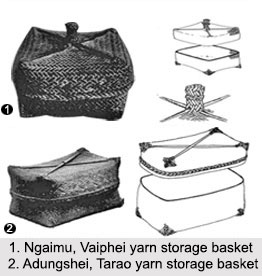 In Manipur, there is a practice of collecting ash by burning sun dried "Laphu-maka" or the outer layers of banana stems, straws and pea plants, amongst the people living in the hills as well as in the valley. The three ingredients are burnt together and the ash thus obtained is used in the preparation of the curry dish Utee. For filtering the ash, a small basket called Shek is used. The Shek is conical in shape, with a circular mouth and a tapering end. On two sides of the circular mouth are extended flaps that act as hand holds, along with a tiny hole maintained at the tip of the tapering end, allowing the filtered solution to pour out. The ash initially collected is first put into the Shek through the open mouth, and water is then poured over it. The filtered solution that comes out is referred to as Kari, an alkaline substance used in the preparation of Utee. The Shek used by the tribal people is of a much bigger size than those used by the Meitheis.
In Manipur, there is a practice of collecting ash by burning sun dried "Laphu-maka" or the outer layers of banana stems, straws and pea plants, amongst the people living in the hills as well as in the valley. The three ingredients are burnt together and the ash thus obtained is used in the preparation of the curry dish Utee. For filtering the ash, a small basket called Shek is used. The Shek is conical in shape, with a circular mouth and a tapering end. On two sides of the circular mouth are extended flaps that act as hand holds, along with a tiny hole maintained at the tip of the tapering end, allowing the filtered solution to pour out. The ash initially collected is first put into the Shek through the open mouth, and water is then poured over it. The filtered solution that comes out is referred to as Kari, an alkaline substance used in the preparation of Utee. The Shek used by the tribal people is of a much bigger size than those used by the Meitheis.
Storage baskets are also used for varied purposes in Manipur and all the tribal groups in the state use a big storage basket with lid, called Tabu, for mainly storing clothes. To enable the men folk to carry such baskets from one place to another, there is a marked position for fixing the straps referred to as Namlee, even without any given holes or loops in the Tabu. Occasionally, to enable carriage of the Tabu from one place to another, straps meant for hand holds are fixed on the upper portion of the basket. In order to secure the lid tightly with the body of the Tabu, a long strap is separately attached to act like a lock. The Tabus slightly differ in feature from one tribe to another and are used by them to store clothes, household utensils and other items to be presented and delivered to the bridegroom`s place as dowry, when a girl gets married. When a tribal girl gets married, it is generally enquired as to how many Tabus are being presented as dowry. People having daughters in their family either make or buy Tabus, and store them in preparation for the eventful day. Tabus are also used in Manipur to store clothes of the officers of the land, and are carried from one village to another in the wake of officials when they move about for their duties.
The structure of the Tabus meant for storing clothes encompasses a double weave: one inner and an outer weave. For the inner weave, the basic form is structure of the bamboo, to which a layer of certain select dry leaves is added. Cane splits are then woven above this layer of dry leaves. The objective of inserting this intermediary layer of dry leaves in between the inner and the outer weaves is to make the basket water resistant against raindrops. The Kom tribal people sometimes keep such baskets up on the shelves of their houses, while generally it is kept inside a room in the house. Maintaining the form of the Tabu basket with double weaving technique, the people of the Tangkhul tribe make small baskets called Chom, to store valuable items.
The tribes of Manipur also use a small basket with lid for storing yarn and other valuable items, called Ngaimu. It is used by the Vaipheis who have ingeniously contrived a handle on the lid serving as the hand hold.
Related Articles:
Bamboo and Cane Crafts of Manipur
Crafts of Manipur
Baskets
Basket Weaving Techniques in Manipur
Tribes of Manipur, Indian Tribals
Cane and Bamboo Products of Manipur
Meithei Language
Manipur
Baskets used by Tribes of Manipur
